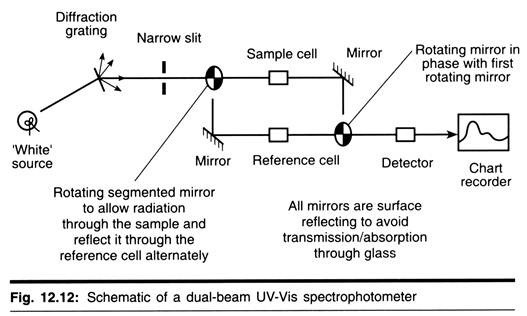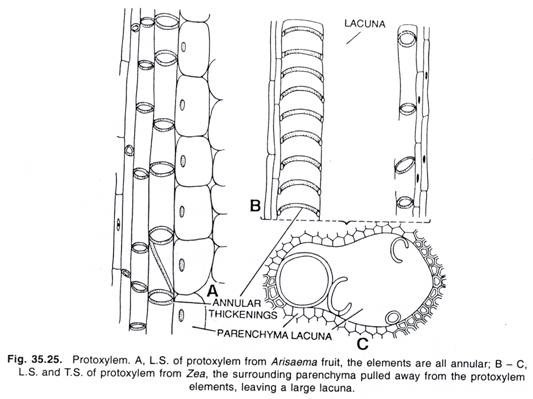In this article we will discuss about the cell structures in algae with the help of diagrams.
I. Cell Wall:
Cell wall of most algae is cellulosic. It also contains hemicellulose, mucilage, pectin and other substances like alginic acid, fucoidin, fucin, calcium carbonate, silica etc. in different combinations in different groups of algae. Electron microscopic studies reveal that the cellulosic wall is composed of cellulose microfibrils of varying thickness that remain variously oriented in a granular matrix.
The diatom cell wall is silicified and shows characteristic secondary structures. In Cyanophyceae, the cell wall is composed of mucopeptide consisting mainly of a peptide of few amino acids covalently bonded to amino- sugars, glucosamine and muramic acid.
This muco- complex is also present in the cell wall of bacteria. A true cell wall is absent in certain algae like Gymnodinium and Pyramimonas. Instead they possess a boundary membrane known as pellicle.
II. The Protoplast:
The protoplasmic content of a cell is called protoplast. The eukaryotic algal protoplast is surrounded by a lipoproteinaceous external boundary, called cell membrane, and consists of one or more usually spherical or ellipsoidal nucleus and cytoplasm.
The cell membrane is made up of lipid and protein and is fluid mosaic in nature like all other biological membrane systems. It is very thin and elastic and selectively permeable. It controls the passage of materials in and out of the cells.
In all eukaryotic algae (Chlorophyceae etc.), the nucleus is a well-organised spherical or elliptical body. It remains surrounded by a distinct nuclear membrane. The inner side is occupied by a chromatin reticulum embedded in a matrix called karyolymph. The nuclear membrane is double layered. The outer membrane is continuous with the endoplasmic reticulum.
Each nucleus contains one or more nucleoli or endosomes. The number of nucleoli varies in different algae. It may be one, two or more. The chromosomes may have a localised or diffused centromere. The number of chromosomes vary from species to species —the lowest number being n=2 (e.g., Porphyra linearis), while the highest is n=592 (Netrium digitali).
In eukaryotic algal cell there are membrane bound cell organelles like chloroplasts, mitochondriai, golgi apparatus, endoplasmic reticulum and, in some cases, eye spot or stigma.
In prokaryotic algal cell (Cyanophycean members), the nucleus is not bounded by any membrane. Instead, the protoplast is differentiated into the outer peripheral chromoplasm containing photosynthetic pigments and an inner colourless centroplasm where the genetic material is not found within the membrane-bound nucleus and the DNA strands do not combine with histones to form chromosomes.
Thus the centroplasm represents the incipient nucleus in Cyanophyceae. The nucleus in Dinophyceae is also not truly eukaryotic, although it is membrane-bound, but chromosomes and mitotic apparatus are absent. The cytoplasm of algal cell is divided into cell organelles and cytosol.
1. The Chloroplast:
Chloroplasts are the very prominent feature of algal cells. They bear the photosynthetic pigments. It is a double-membrane structure.
Various forms of chloroplasts are known to occur in different types of algae, of which eight main types are usually recognised : cup shaped (e.g., Chlamydomonas and Volvox), discoid (e.g., Chara, Vaucheria and centric diatoms), parietal (e.g., Chaetophorales, Phaeophyceae, Rhodo- phyceae, many Chrysophyceae and pinnate diatoms), girdle shaped or C-shaped (e.g., Ulothrix), spiral (e.g., Spirogyra), reticulate (e.g., Oedogonium, Hydrodictyon and Cladophora), stellate (e.g., Zygnema), and ribbed (e.g., Volvocales). The basic structure of chloroplast is almost similar throughout the plant kingdom.
There are three major structural regions in the chloroplast:
1. An envelope consisting of two membranes with an enclosed space.
2. The mobile stroma containing the soluble enzymes for metabolism, protein synthesis and starch storage, and
3. The highly organised internal lamellar membranes containing pigments and involved in energy capture and transduction.
The internal lamellar system forms discs which are stacked together like piles of coins to form grana. Each disc is a sac or vesicle and termed as thylakoid. Each thylakoid encloses an interthylakoid space.
The thylakoid system constitutes a single, complex cavity, separated from stroma by the thylakoid membrane. Built into the thylakoid membranes are pigment systems and electron carriers, which carry out the light phase of photosynthesis.
In Cyanophyceae, the thylakoids are not enclosed in membrane bound groups to form chloroplasts, instead they lie free in the cytoplasm. The thylakoids are the site of chlorophyll a, and the accessory pigments also occur on their surface in the form of small vesicles called the phycobilisomes.
a. Pigmentation:
The pigments that provide the actual colour of the thallus are of various types:
i. Chlorophylls:
There are five types of chlorophylls found in algae, Chi a, b, c, d, and e. Of them, chlorophyll a is present in all groups of algae. Chlorophyll b is found only in Chlorophyceae, Chlorophyll c in Phaeophyceae, Cryptophyceae, Bacillariophyceae and Chrysophyceae, Chlorophyll d in some red algae, and chlorophyll e in certain Xanthophyceae.
ii. Caroteinoids:
Carotenes and xanthophylls together constitute the carotenoids. They are accessory photosynthetic pigments.
Five types of carotenes are found in algae: α-carotene in Chlorophyceae, Cryptophyceae and Rhodophyceae; β-carotene in all algal groups, except Cryptophyceae; c-carotene in Chlorophyceae; e- carotene in Bacillariophyceae, Cryptophyceae, Phaeophyceae and Cyanophyceae and flavacene in. members of Cyanophyceae.
iii. Xanthophylls:
Several types of xanthophylls are found in algae. Of them lutein, violaxanthin and neoxanthin are found in the members of Chlorophyceae and Phaeophyceae. Fucoxanthin is the main xanthophyll pigment in Phaeophyceae and Bacillariophyceae, whereas myxoxanthophyll, myxoxanthin and oscilloxan- thin are found only in Cyanophyceae.
iv. Phycobilins:
Phycobilins are water- soluble linear tetr’apyrroles. They are biliproteins of either red (phycoerythrin) or blue (phycocyanin) in colour. They are found only in Rhodophyceae and Cyanophyceae. They function as accessory pigments by absorbing and transferring the light energy to the reaction centre.
b. Pyrenoids:
Pyrenoids are proteinaceous bodies present in chloroplasts or chromatophores — the very characteristic of algal chloroplasts. They are usually associated with the synthesis and storage of starch. In Bacillariophyceae they accumulate lipid. The number of pyrenoid may be one (e.g., Chlamydomonas) or more than one (e.g., Oedogonium) per chromatophore.
2. Mitochondria:
Mitochondria are found in all algal cells except Cyanophyceae. Each mitochondrion is surrounded by a double membrane envelope. The inner membrane of plant mitochondria encloses an aqueous matrix of solutes, soluble enzymes and the mitochondrial glucose.
The inner membrane is larger than the outer membrane and undergoes invagination producing sac-like cristae of variable shape and number — usually with a narrow neck. The whole mitochondrion is again encircled by an outer membrane lying close to the inner one, leaving an intermembrane space which is continuous with the intercristal space.
The matrix is finely granular and highly proteinaceous. The organelle is semiautonomous in nature as it contains a circular DNA and ribosomes of its own, with the help of which it can synthesise some of its proteins. There is usually more than one mitochondrion per cell, but in Micromonas (Chlorophyceae) each cell contains a single mitochondrion
The cells of blue green algae lack mitochondria. The cytoplasmic membrane is the site of biochemical functions normally associated with the well-defined membranous organelles in eukaryotic cells. Like bacteria the cell membrane invaginates to form a structure called the meso-some where the respiratory enzymes are localized.
3. Endoplasmic Reticulum (ER):
Electron microscopic studies indicate that the algal cells contain an extensive membrane network of interconnecting tubules and cisternae (flattened sac), called the endoplasmic reticulum. The ER membranes traverse the entire cytoplasm.
The reticulum consists of interconnected parallel cisternae associated with ribosome, attached to the cytoplasmic face of the membrane. This form of ER is known as rough endoplasmic reticulum (RER) which is a major site of protein synthesis. On the contrary the ER membranes that do not bear ribosome are called smooth endoplasmic reticulum (SER).
4. Dictyosomes or Golgi Apparatus:
Dictyosomes or Golgi bodies are found in all algal cells except blue-green algae, and can be seen under the electron microscope. The Golgi apparatus is a component of the endomembrane system of the cell and appears to serve as an intermediate between the endoplasmic reticulum and plasma membrane.
Golgi bodies may be found in the region of the nucleus (e.g., Chlamydomonas), near plastids (e.g., diatom and Bulbochaete), or it may be found anywhere in the cell. Golgi bodies are composed of 2-20 flat vesicles which are arranged in stacks.
Each stack is called dictyosome. All dictyosomes collectively form the Golgi apparatus. It functions in the packaging of materials for export to the cell’s exterior. It is also responsible for the formation of new plasma membrane to support growth or to replace the lost one.
5. Eye-Spot or Stigma:
The motile vegetative and reproductive cells of algae have a pigmented spots in the anterior, middle or posterior part of the cell, known as eye-spot or stigma (Fig. 3.12). It is involved directly or indirectly in light perception. The stigma is usually found within the thylakoids run longitudinally through the eye-spot in between two rows of granules.
6. Vacuoles:
Almost all the algal cells, except the members of Cyanophyceae, possess one or more vacuoles. Each vacuole is bounded by a distinct membrane called tonoplast.
Three types of vacuoles are found in motile forms:
(i) Simple vacuole:
They are very small in size and show periodic contraction and expansion. They are also called contractile vacuoles. They throw out the metabolic wastes of the cells. They also regulate the water content of the cell by discharging the excess amount at short interval. So they are secretory in function.
(ii) Complex Vacuole:
This is the characteristics of Dinophyceae and Euglenophyceae. It consists of a tube-like cytopharynx, a large reservoir and a group of vacuoles of varying sizes. The vacuoles perform the function of osmoregulation inside the cell. Sometimes, the vacuoles also store reserve food materials such as laminarin and chrysolaminarin.
(iii) Gas Vacuoles:
In the cells of the members of Cyanophyceae there are gas containing cavities occurring as stacks of small transparent cylinders of uniform diameter. Their walls are freely permeable to gases. The gas vacuoles give buoyancy to the planktonic forms and also serve as protective screens against incident bright light.
7. Flagella:
Motile vegetative or reproductive cells are present in all groups of algae except Cyanophyceae and Rtiodophyceae. The movement is achieved by the beating action of small filiform or thread-like protoplasmic appendages, called flagella. They vary in. number, length, position and presence or absence of hairs in different numbers. The number varies from one to four or many.
They are mainly of two types:
1. Whiplash or Acronematic:
These are hairless smooth surfaced-.flagella (Fig. 3.13A, Fig. 3.14A), and
2. Tinsel or Pleuronematic:
They are having one or more rows of lateral fine filamentous hairs known as mastigonemes or flimmers
They are further categorised into:
a. Pantonematic. Where the mastigonemes are arranged in two opposite rows (Fig. 3.13B).
b. Pantoacronematic. Pantonematic flagellum with a terminal fibril is called pantoacronematic (Fig. 3.13C).
c. Stichonematic. It has one-sided mastigonemes (Fig. 3.13D).
If the number of flagella per cell is more than one and identical, it is known as isokont and when dissimilar, it is known as heterokont.
Flagellar Roots in Algae:
Flagella are the extremely fine, hyaline emergence of cytoplasm. Commonly there is a single granule at the base of each flagellum (Fig. 3.15A), the blepharoplast or basal body. If algal cell has a firm wall, the flagellum emerges through a pore.
Each flagellum has a central or axial thin filament, the axoneme. The axoneme is surrounded by a cytoplasmic membrane or sheath formed by an extension of the cell or plasma membrane. The sheath ends just short of the apex of the flagella. The apical naked portion of the axoneme is called end-piece.
In transverse section, the flagellum (Fig. 3.15B) shows two central singlet fibrils surrounded by nine peripheral doublet fibrils. Each fibril is covered by a membrane and the two central ones are further covered with an additional membrane.





